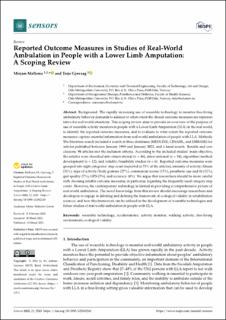Reported Outcome Measures in Studies of Real-World Ambulation in People with a Lower Limb Amputation: A Scoping Review
Peer reviewed, Journal article
Published version
Permanent lenke
https://hdl.handle.net/11250/2996516Utgivelsesdato
2022-03-14Metadata
Vis full innførselSammendrag
Background: The rapidly increasing use of wearable technology to monitor free-living ambulatory behavior demands to address to what extent the chosen outcome measures are representative for real-world situations. This scoping review aims to provide an overview of the purpose of use of wearable activity monitors in people with a Lower Limb Amputation (LLA) in the real world, to identify the reported outcome measures, and to evaluate to what extent the reported outcome measures capture essential information from real-world ambulation of people with LLA. Methods: The literature search included a search in three databases (MEDLINE, CINAHL, and EMBASE) for articles published between January 1999 and January 2022, and a hand-search. Results and conclusions: 98 articles met the inclusion criteria. According to the included studies’ main objective, the articles were classified into observational (n = 46), interventional (n = 34), algorithm/method development (n = 12), and validity/feasibility studies (n = 6). Reported outcome measures were grouped into eight categories: step count (reported in 73% of the articles), intensity of activity/fitness (31%), type of activity/body posture (27%), commercial scores (15%), prosthetic use and fit (11%), gait quality (7%), GPS (5%), and accuracy (4%). We argue that researchers should be more careful with choosing reliable outcome measures, in particular, regarding the frequently used category step count. However, the contemporary technology is limited in providing a comprehensive picture of real-world ambulation. The novel knowledge from this review should encourage researchers and developers to engage in debating and defining the framework of ecological validity in rehabilitation sciences, and how this framework can be utilized in the development of wearable technologies and future studies of real-world ambulation in people with LLA.

